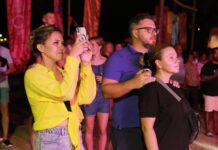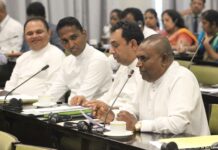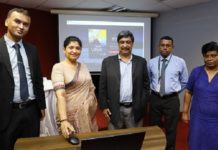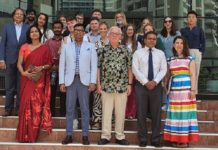Mob violence erupted across Sri Lanka on Monday (09) as angry crowds torched residences and offices of government MPs, destroyed vehicles and assaulted scores of suspected pro-government goons after a ruling party attempt to unleash violence on a peaceful protest in Colombo catastrophically backfired.
Chaos reigned all day and late into the night as the violence continued seemingly unabated around the island with mobs of hundreds descending upon people and property affiliated with the ruling Sri Lanka Podujana Peramuna (SLPP).
The violence was sparked after a group of pro-government ‘protestors’ who had gathered at Temple Trees – the official Colombo residence of Prime Minister Mahinda Rajapaksa – urging him to stay on as PM despite countrywide demands for his resignation along with that of his brother President Gotabaya Rajapaksa launched an unprovoked attack on peaceful protestors outside Temple Trees.
The pro-Rajapaksa protestors, who had reportedly been transported to Temple Trees in a fleet of private buses, were addressed by Prime Minister Rajapaksa and SLPP MPs Pavithra Wanniarachchi, Rohitha Abeygunawardena and Johnston Fernando. Fernando’s speech was said to be particularly vociferous.
The group then made their way to the MynaGoGama protest site, where anti-government protestors had been demonstrating peacefully since late April demanding the prime minister’s resignation. The situation quickly descended to violence as the pro-Rajapaksa protestors assaulted the MynaGoGama protestors and ripped up their tents and set the remaining structures on fire.
The MynaGoGama protestors attempted to fight back, but were easily outnumbered and overpowered by the attackers. News footage showed multiple MynaGoGama protestors being beaten up while police looked on seemingly helpless.
After totally destroying the MynaGoGama camp, the pro-Rajapaksa gang made their way to the main anti-government protest site at Galle Face, the self-styled GotaGoGama where protestors have been demanding peacefully for over a month that President Rajapaksa step down over his role in what has become Sri Lanka’s worst economic crisis in its 74-year post-Independence history.
Within minutes, the protest site – which had been home to a veritable sea of tents, performance stages, food trucks and even a makeshift library – turned into something akin to a warzone after the pro-government mob laid waste to nearly everything that had made it a unique and unprecedented site of civic engagement.
Eyewitnesses said the invaders were met with minimum resistance by police during much of the protest site’s destruction, despite a state of emergency in place, though police was later forced to fire tear gas and water cannon bursts to disperse the crowds.
It was too little, too late. One half of the GotaGoGama camp was more or less razed to the ground by the time the police decided to act. Tents were in tatters and protestors looked dazed and confused even as anger started to boil in them. The fury in the air was palpable. The anti-government protestors were beaten but not defeated as they vowed to rain fire and brimstone on the pro-Rajapaksa crowd, some of whom, it has now transpired, were coerced into being there.
Opposition Janatha Vimukthi Peramuna (JVP) leader Anura Kumara Dissanayake soon arrived at the site where he was seen expressing solidarity with the GotaGoGama protestors who had gathered round him to complain. Opposition leader Sajith Premadasa who also arrived not long after was in for a significantly less than warm welcome as some of the protestors attempted to assault him. Some were seen hurling bottles at the man that might’ve become President of Sri Lanka had 6.9 million voters decided differently.
A human barrier was formed by lawyers from the Bar Association of Sri Lanka (BASL) which, ever since the anti-government agitations began, had been throwing its weight behind theprotestors against alleged government suppression. Members of the Inter-University Students Federation (IUSF) also joined.
By mid afternoon, a curfew was announced and was promptly ignored by a growing mob of anti-government protestors in and around Galle Face, Temple Trees, and Perahera Mawatha, who seemed to be rounding up whoever remained of the Rajapaksa supporters. It didn’t seem to matter at this point that the premier had resigned, effectively ending the government. President Rajapaksa was still standing.
Fleeing remnants of the pro-Rajapaksa group were chased right into the Beire Lake where they were forced to tread water with some of the very vehicles that had transported them to Colombo that had been toppled over by angry protestors.
It didn’t take long for open violence to breakout. A large mob of people – it was unclear at this point where they were from or whether they had any direct link to the Galle Face protestors – had gathered at the back entrance of Temple Trees on Perahera Mawatha. They were braying for blood, and they got what they had come for. At least two people that had been fished out of the lake were beaten to within an inch of their life by the mob. Another man who was beaten up outside the parking lot of a leading Colombo hotel was stripped naked.
The mob had taken to their own hands what for all intents and purposes was a mop-up operation, rounding up and beating the remaining pro-Rajapaksa crowd senseless. Police, meanwhile, seemed largely helpless or unwilling to intervene.
Meanwhile, a wave of organised violence was sweeping the country. Buses leaving Colombo were stopped by mobs, and passengers were pulled out for questioning, reportedly to ascertain whether they had been part of the pro-Rajapaksa crew. In some areas, vehicles stood empty in the middle of the road, their windows smashed in. In one incident, a ruling party MP’s vehicle was attacked and the lawmaker was killed in an apparent shooting during the commotion. The assailant has yet to be identified.
The country swiftly descended into chaos as government MPs’ private residences were set ablaze by some organised, some organic groups. Anti-government protestors, who had been largely peaceful till now, rose up with a vengeance, taking their frustrations out on the politicians they held personally responsible for Sri Lanka’s multiple crises.
Homes and offices of prominent SLPP MPs were looted or set on fire, and several political figures were assaulted by enraged anti-government protestors or mobs. Public property too, was damaged.
Roads were blocked, leaving many people stranded and fearful of being attacked. Passersby were ordered by rioters not to video-record their acts of violence.
As night descended, the GotaGoHome protestors commenced rebuilding the site. Those present said they will not leave till Gota (President Rajapaksa) calls it a day. Meanwhile, at nearby Temple Trees, violence rages on.











